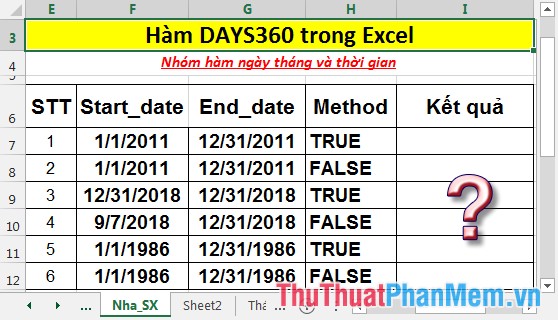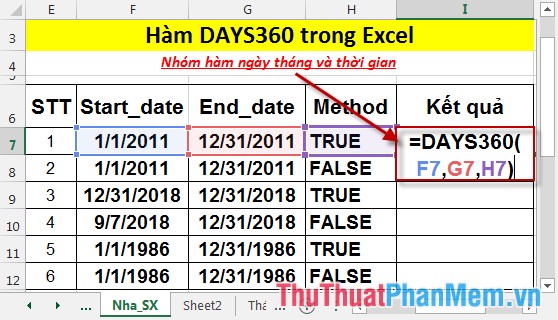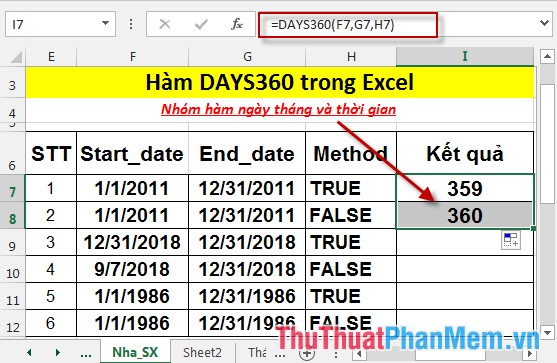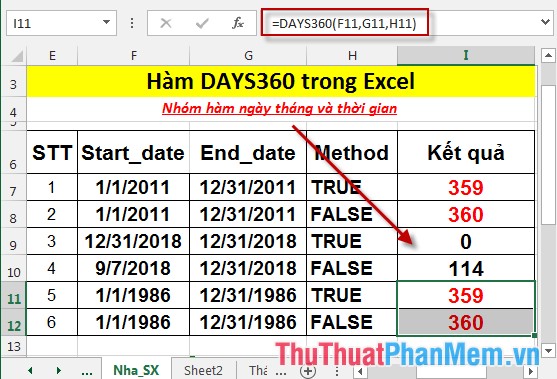DAYS360 function - The function returns the number of days between 2 dates, based on 360 days in Excel
The following article introduces you to the DAYS360 function - one of the functions in the date and time group function is very popular in Excel.

Description: The function calculates the number of days between 2 dates, based on 360 days per year (from 12 months, 30 days per month). Useful function in calculating payments in the accounting system based on twelve months 30 days.
Syntax: DAYS (start_date, end_date, [method])
Inside:
- start_date: End date to calculate the number of days, is a required parameter.
- end_date: The start date to calculate the number of days, is a required parameter.
- method: A logical value that determines how the date is calculated, an optional parameter with the following values:
+ method = FALSE or skip -> calculate the number of days in US method (NASD). The end date of the month is the 30th day, if the end date is earlier than 30 days, the end date will be equal to the first day of the following month.
+ method = TRUE -> calculate the number of days in European method , the start date and end date of the month on the 31st of the month will equal the 30th day of that month.
Attention:
- If 1 of the 2 arguments end_date and start_date is outside the valid range of the day -> the function returns the #NUM! Error value
- If 1 of the 2 arguments end_date and start_date cannot be parsed into a valid date -> the function returns the #VALUE! Error value
For example:
Calculate the number of days between dates in the table below:

- In the cell to calculate enter the formula: = DAYS360 (F7, G7, H7).

- Press Enter -> return value is:

- Similarly copy the formula for the remaining value with method = False.

- Here the same value but different methods -> different values.
- Similarly copying the formula for the remaining values results:

Above are detailed instructions and some specific examples when using the DAYS360 function in Excel.
Good luck!
You should read it
- NETWORKDAYS function - The function returns the number of whole working days between 2 dates in Excel
- NETWORKDAYS.INTL function - The function returns the number of whole working days between 2 dates, specifying weekends in Excel
- YEARFRAC function - The function returns the fifth calculated by the number of whole days between two specific dates in Excel
- DATEDIF function - The function calculates the number of days, months, years between 2 dates in Excel
- DAYS function, how to use the function to calculate the number of days between two time points in Excel
- The WORKDAY function - The function returns a date before or after the start date of a number of working days in Excel
 EDATE function - Add and subtract months to a specified date in Excel
EDATE function - Add and subtract months to a specified date in Excel EOMONTH function - The function returns the last day in the month before or after 1 day of a specified number of months in Excel
EOMONTH function - The function returns the last day in the month before or after 1 day of a specified number of months in Excel HOUR function - The function returns the hour of a time value in Excel
HOUR function - The function returns the hour of a time value in Excel ISOWEEKNUM function - The function returns the ordinal number of the year of the week that contains the given date in Excel
ISOWEEKNUM function - The function returns the ordinal number of the year of the week that contains the given date in Excel MINUTE function - The function returns minutes of a time value in Excel
MINUTE function - The function returns minutes of a time value in Excel MONTH function - The function returns the monthly value of a day expressed as a serial number in Excel
MONTH function - The function returns the monthly value of a day expressed as a serial number in Excel